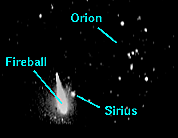 Hannover, 1995 |
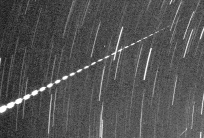 Perseid Shower, 1996 |
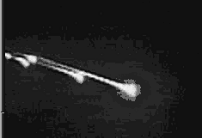 Peekskill, 1992 |
Interplanetary space is littered with rocks tens of meters in diameter or less. When these meteoroids strike the Earth's atmosphere at high relative speeds they leave visible trails created when the intense heat caused by friction vaporizes them. These are called meteors ("shooting stars").
 Hannover, 1995 |
 Perseid Shower, 1996 |
 Peekskill, 1992 |
The left image shows the path of a fireball recorded over Hannover, Germany. The fireball outshines Sirius and the constellation Orion (Ref). The middle image shows a fireball recorded in the 1996 Perseid meteor shower by the Dutch Meteor Society. The curved streaks are star tracks in the timed exposure. The pulsed nature of the fireball track is produced by the camera which is being chopped. The right image shows a fireball observed for over 20 seconds from Kentucky to New York in 1992 that led to a meteorite fall in Peekskill, New York. In this image the fireball is beginning to break up into smaller pieces. Here is a movie of the Peekskill fireball.
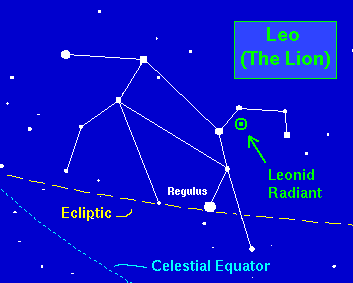 Meteors enter our atmosphere on a regular basis. On a normal night
you can typically see a few sporadic meteors
per hour. However, at certain times the rate of
observable meteors is much higher. These periods are called meteor showers.
Further, during meteor showers (which usually last a few days), the majority of
the meteors appear to come from a particular point in the sky, called the
radiant of the shower.
The adjacent figure illustrates the position of
the radiant for the
Leonid Meteor Shower, and here is a time-exposed image showing clearly the
radiant location
for the 1995 Lyrid Shower.
Meteors enter our atmosphere on a regular basis. On a normal night
you can typically see a few sporadic meteors
per hour. However, at certain times the rate of
observable meteors is much higher. These periods are called meteor showers.
Further, during meteor showers (which usually last a few days), the majority of
the meteors appear to come from a particular point in the sky, called the
radiant of the shower.
The adjacent figure illustrates the position of
the radiant for the
Leonid Meteor Shower, and here is a time-exposed image showing clearly the
radiant location
for the 1995 Lyrid Shower.
The meteor shower is commonly named after the constellation in which this radiant is found, and occurs annually during a well-defined time period. For example, the Perseid meteor shower occurs every year from about July 25th through August 18th, with a peak on August 12, and has its radiant in the constellation Perseus. In this shower, the typical maximum number of meteors that can be seen per hour at its peak is about 70, which is 10 times the rate of sporadic meteors.
Here is an observational determination of the radiant for the Quadrantid shower, and an MPEG movie (movie not working at the moment-- sorry!) (127 kB, compressed in time) showing 18 meteors of the Quandrantid shower. The movie was obtained from this paper, where a more detailed and technical discussion of photographing meteors and meteor showers may be found.
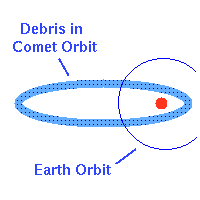
Meteor showers result when the Earth encounters cometary orbits |
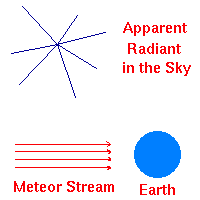
Perspective makes the meteors appear to come from a point in the sky |
As comets move about their orbits they leave a stream of debris because dust and rocky material is liberated from the head as the ices vaporize. If the earth crosses the cometary orbit, this debris leads to an increased number of meteors (left figure). These periods are called meteor showers. That meteors in meteor showers appear to radiate from a single point in the sky is an optical illusion, as illustrated in the figure on the right. The meteor stream that produces the shower has meteoroids moving on essentially parallel trajectories, but because of perspective (parallel lines appear to meet at infinity) the meteors actually entering Earth's atmosphere on parallel trajectories seem to radiate from a point, as viewed from a site on Earth.
| Some Meteor Showers | |||
| Name | Date of Maximum |
Meteors / Hour at Max |
Parent |
| Quadrantids | Jan. 4 | 110 | - |
| Perseids | Aug. 12 | 68 | Comet 1862 III |
| Orionids | Oct. 21 | 30 | Comet Halley |
| Leonids | Nov. 17 | 10 | Comet P/Tempel-Tuttle |
| Geminids | Dec. 14 | 58 | 3200 Phaethon |
Here is a more extensive listing of meteor showers and their characteristics.
 Meteor showers often vary in intensity from year to year, presumably reflecting
details of encountering the orbit of the parent comet. One shower that
normally is rather weak, but can at times be strong is the Leonids. As the
preceding table indicates, on the average it only gives 10 meteors per
hour---not even twice the sporadic rate.
The Leonids grew stronger in 1998 and
1999 and
produced 10,000 or more per hour at the peak (when the parent comet is near
perihelion). The
rate was predicted to be as high as 40 meteors per second (!)
for a short period; a veritable meteor storm though not observed
to be quite this much.
Meteor showers often vary in intensity from year to year, presumably reflecting
details of encountering the orbit of the parent comet. One shower that
normally is rather weak, but can at times be strong is the Leonids. As the
preceding table indicates, on the average it only gives 10 meteors per
hour---not even twice the sporadic rate.
The Leonids grew stronger in 1998 and
1999 and
produced 10,000 or more per hour at the peak (when the parent comet is near
perihelion). The
rate was predicted to be as high as 40 meteors per second (!)
for a short period; a veritable meteor storm though not observed
to be quite this much.
Such predictions often do not pan out, but there is historical precedent for spectacular outbursts from the Leonids. On November 12-13, 1833, a "tempest of falling stars" was observed in Boston with a rate "half that of flakes of snow in an average snowstorm", while in the 1966 the Leonids produced "a hail of meteors too numerous to count" according to one observer and 150,000 per hour for a 20 minute period according to another (Reference). Newspaper accounts of the time reported that many people were awakened from sleep either by the shouts of neighbors, or the light of the meteors in the sky.
Adolf Vollmy made a wood-cut engraving based upon an original painting by the Swiss artist Karl Jauslin, that is in turn based on a first-person account of the 1833 storm by a minister, Joseph Harvey Waggoner. According to Waggoner's account, "... it is not possible to give in a picture a representation of the stars falling at all points of the compass at once. But they fell in myriad's to the north, east, south and west. Any representation on paper must at best be a very limited idea of the reality"
The November, 1998 Leonid shower was spectacular sight. To help you keep track of Leonid meteor showers, here is the Leonid Meteor Outburst Mission HomePage, a set of For good measure, here is the orbit and present position of the parent comet, P/Tempel-Tuttle.
These studies indicate that P/Tempel-Tuttle is in an unusual orbit for a comet, because it (1) comes close to the Earth's orbit, but (2) has a period sufficiently long that its orbit is only slightly perturbed by the planets. Comets with short periods that come close to the Earth typically do so only a time or two before gravitational interactions with the planets (primarily Jupiter) disturb them into other orbits. But P/Tempel-Tuttle's orbit has been relatively stable for many centuries and meteor storms have been seen for more than 1000 years that we now know are associated with this comet.